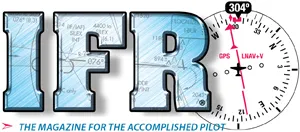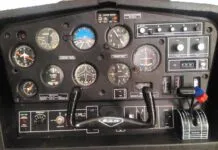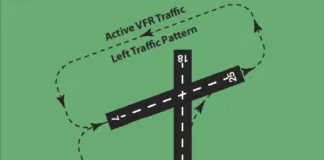Quiz Goof
The November quiz was hands down the best summary of SIDSs and ODPs I have ever read. Curious about your answer to Question 8, “A charted SID procedure . . .” Your explanations are about the differences between SIDs and ODPs but they have nothing to do with the answer choices? Did I miss something?
—Richard Cassel, Los Angeles, California
No, you didn’t miss anything. We did. You’re right. Not sure how we messed that up.
We checked, and it was that way in the original, not edited in as most often happens. But, the original submission is reviewed before sending, then it’s copy edited. Finally, the quiz gets transcribed into the magazine where it gets two more proof-reading steps. Uhhh, oops.
Here’s what it should have been:
A SID is part of an IFR clearance and is only established at an airport with at least one approach. Not uncommonly, a SID can serve multiple airports. Although an ODP also requires an instrument approach, it is airport-specific since it addresses obstacles near a particular airport.
Bad Taste
I found the incident described by reader Jerome Bierut in a recent OTA to be more harassing and demeaning of the “female ground controller” mentioned in the first paragraph, than to be humorous.
Being in the far minority of aviation professionals and enthusiasts, and being so for decades, women have a hard enough time in the field; having inappropriate behavior like this laughed off is just an additional barrier to full acceptance.
Thank you for your attention.
—Gabrielle Adelman,Corralitos, California
You’re absolutely right, Gabrielle.
Sometimes we get on autopilot putting this stuff together, especially when we’re short on material as we so often are with OTA. We check spelling, punctuation, and layout but sometimes don’t really consider the content enough. That’s produced some questionable content like this on more than one occasion.
Thanks for pointing this out. We’ll try to remain more fully engaged to better evaluate content in the future. We apologize for publishing this particular item that was in bad taste, while sadly noting that we wish more readers would have scolded us for it.
Why There?
I’m curious as to why the RAYOK intersection on the ILS 4 approach at Quincy is identified by UIN 7 DME and not I-UIN to identify its source as the localizer antenna regardless of no collocated Quincy VOR. Thank you.
—Steve Wagner, Stillwater, Minnesota
There are a few interesting aspects to your question.
Let’s first cover some basics. Although we use a VOR receiver to tune a localizer, the localizer is a different beast. The glideslope, if present, is a completely different transmitter that operates on a different frequency. But, by standards, the frequency of the glideslope is paired with the localizer frequency, so that tuning the localizer frequency provides the information the glideslope receiver needs to tune the glideslope.
DME is yet another piece of equipment that operates on yet another frequency. Just as localizer frequencies are paired with glideslope frequencies, so are DME frequencies paired with VOR/LOC frequencies, such that when you tune the VOR or LOC, the DME knows what frequency it should be using.
Okay, that’s enough background for now.
For someone who’s not used to flying with an actual DME, the depiction of DME distances on FAA charts, particularly on approach charts, can be confusing. On the KUIN ILS or LOC RWY 4 approach chart, the intermediate fix RAYOK is shown as being seven DME from UIN. While these DME distances on the approach charts are often relative to something on or near the airport, that’s not always the case. If a distance is inside the D symbol at it is here, the distance cited is actual DME, not a GPS distance to any other fix than the one shown.
Here, UIN—actually a TACAN station, so only the DME portion is useful to civilian pilots—is not on the airport, but is located about three miles closer to RAYOK than the Quincy LOM/IAF and slightly south of the localizer course. We don’t know why the UIN TACAN isn’t depicted on the approach chart. Regardless, without GPS or some form of RNAV, RAYOK can be located on the localizer course at seven DME from the UIN TACAN.
As for why this wasn’t charted as distance from the localizer itself, look at the localizer frequency box. These boxes always list two bits of information with an optional third. The first line will always state “Localizer” and then the frequency. Tune that frequency directly for the localizer and, if there’s a glideslope present, that receiver will be tuned to the paired frequency for the glideslope. The second piece of information is the identifier and the Morse code depiction of the identifier.
The optional third bit of information will be the word “Channel” followed by a number. For civilian uses, this is obsolete information that refers to the DME channel number assigned to the actual frequency of the DME.
But, since your DME, should you have one, knows those relationships you merely tune the frequency of the TACAN (VOR for our purposes) and the paired DME frequency is automatically tuned by your DME equipment. If this third bit of information, the DME channel number, is absent, there is no DME equipment collocated with the localizer.
The frequency box for the Quincy localizer has no such channel number. Thus, there is no DME equipment at the localizer. Thus, identifying RAYOK’s position must be done using another source, such as a radial from another navaid, or, in this case, the distance from another navaid.
As an aside, the apparent disconnect or discrepancy between DME distances shown on approach charts and the distances I’d see on my GPS led me to retain DME in my airplane to prevent confusion. Few pilots do that, probably figuring that one moving map is worth a hundred DME distances, and they’re probably right. But, I learned to fly instruments long before GPS was even considered, so I kept my old-school DME and avoid the occasional confusion like this.
—Frank Bowlin
New Tricks for an Old Dog
I have been flying for many years, primarily single pilot in light twins. When I changed airports and needed a new CFII/MEI, I found an ex-airline pilot. During my first IPC he showed me a simplified approach checklist that I have adopted.
Basically, he uses the audio panel as his checklist. Touch Nav1 and Nav2 to setup navigation radios. Touch Com1 and Com2 to setup communication radios. Touch Marker to brief approach (inbound course, MDA/DH, time, initial missed approach).
This has been a valuable tool for me in not missing any steps when briefing the approach without having to fumble with another piece of paper. (I already have an approach chart somewhere.)
In addition to the above tip, I flew with another airline pilot and he suggested that I set up my panel based on threat analysis. Basically, he saw that I routinely displayed my route on my PFD, plus on the screen of both navigators. His comment was to ask if the route is my most critical threat when departing from an uncontrolled airport? Why not display traffic on the number two navigator? At other points in a flight that navigator might be used to display weather or terrain, etc. I have also adopted this as it makes a lot of sense to me.
I haven’t seen other pilots I interact with using these techniques. Since I find them so valuable, I thought they might be of interest to your readers.
I guess you can teach an old dog new tricks.
—Allen Holman, Knoxville, Tennessee
Good tips, Allen. Thank you.
We read ’em all and try to answer most e-mail, but it can take a month or more. Please be sure to include your full name and location. Contact us at Frank@IFR-Magazine.com.





